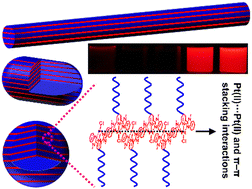Synthesis of platinum(ii)-complex end-tethered polymers: spectroscopic properties and nanostructured particles†
Abstract
Although metal-containing polymers have been widely studied as a novel class of functional soft materials, the microphase separation between polymeric segments and metal–ligand complexes has been less addressed, which is critical to control their structures and functions. To do this, short-chain polystyrenes (PSs) have been end-functionalized with nanosized square-planar platinum(II) complexes. The platinum(II)-comprising polymers were found to show significant luminescence enhancement in chloroform/methanol solvent mixtures upon increasing the methanol composition. By modulating both the PS length and solvent quality, various self-assembled morphologies formed controllably in the mixed solvents and typical examples include nanofibers, nanoellipsoids, and nanospheres. More interestingly, the inside structures of these polymer particles are shown to be lamellar with sub-10 nm spacings, wherein the PS blocks are alternatively aligned with the platinum(II) units. Such a luminescence enhancement and hierarchical nanostructured particles originate from a subtle combination of directional Pt(II)⋯Pt(II) and/or π–π stacking interactions between the platinum(II) units and the solvophobic effect between the PS blocks. This work suggests that by microphase separating polymer chains with nanosized metal–ligand complexes, metal-containing polymers can self-assemble to form sub-10 nm scale nanostructures showcasing desired properties and functions.

- This article is part of the themed collection: Soft Matter Recent HOT Articles


 Please wait while we load your content...
Please wait while we load your content...